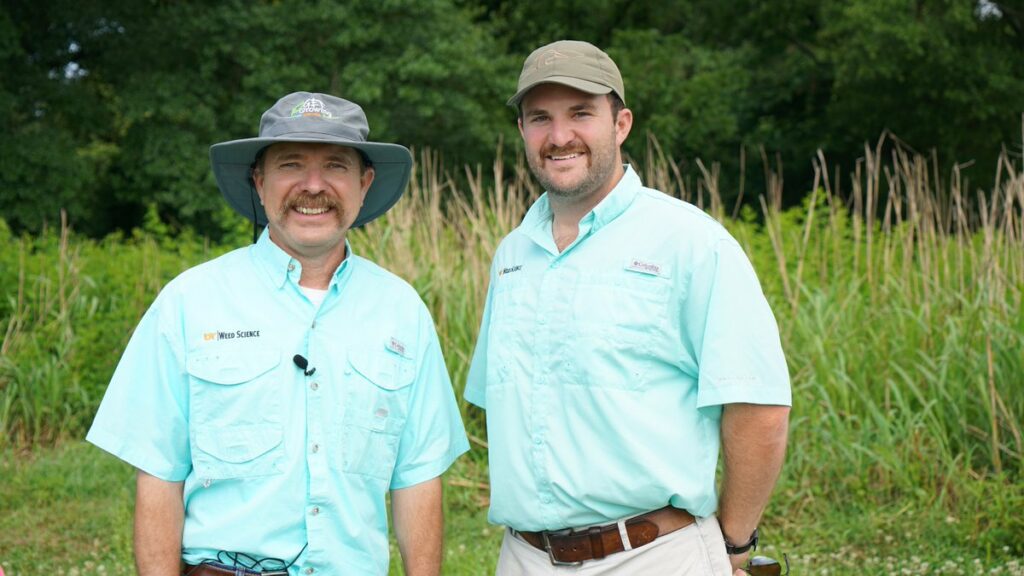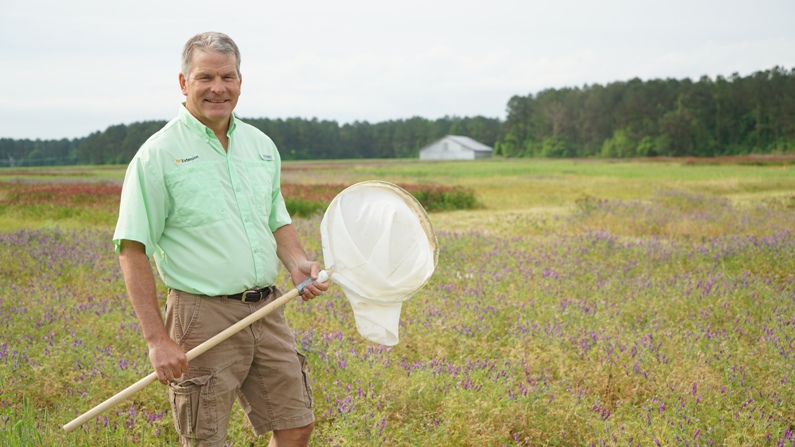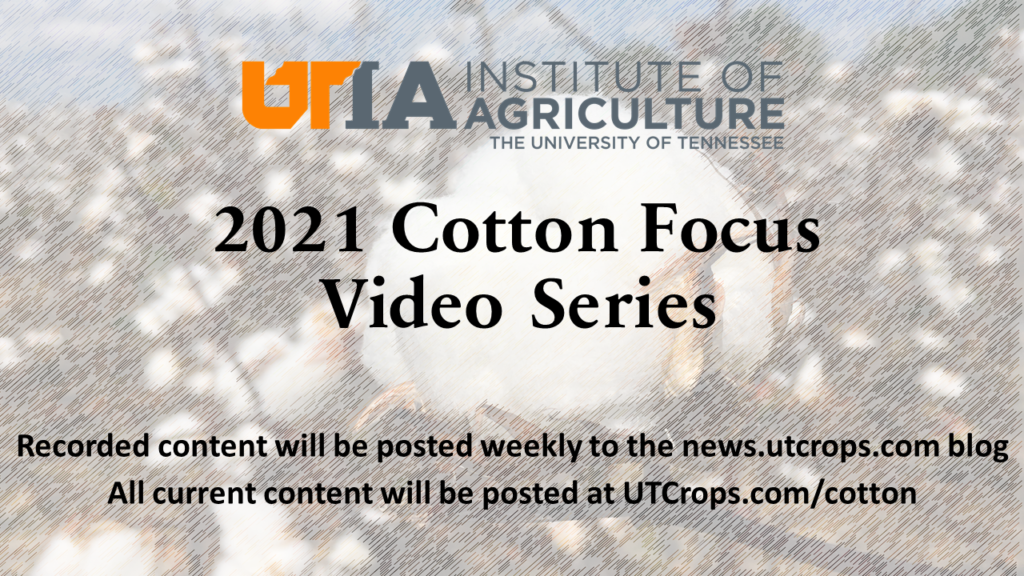It sounds like there is a little more interest in planting grain sorghum this spring compared to more recent years. As such producers who have never planted grain sorghum or have not planted it in years may be trying some this year. With this in mind here are some pointers on weed management recommendations in grain sorghum. Continue reading
Category Archives: Cotton
2021 Cotton Focus Video Series: U.S. Cotton Trust Protocol: Sustainability by Dr. Lori Duncan
 The US Cotton Trust Protocol is a new program for US cotton that enables producers to measure their sustainability on the farm and transfer that information down the supply chain, ultimately to the brands and retailers. Because consumers are demanding more traceability, this platform enables US cotton growers greater market access.
The US Cotton Trust Protocol is a new program for US cotton that enables producers to measure their sustainability on the farm and transfer that information down the supply chain, ultimately to the brands and retailers. Because consumers are demanding more traceability, this platform enables US cotton growers greater market access.
In this week’s Cotton Focus video, Dr. Lori Duncan, Crop Sustainability Specialist, gives a brief overview of the need for the Trust Protocol and the enrollment process. Mr. John Lindamood, a cotton grower from Tiptonville and a leader in the cotton industry, joined Dr. Duncan in a virtual visit to discuss his viewpoint as a participant in the Trust Protocol. In this conversation, he details the need he sees for this new program as well as his experience in the enrollment process. We very much appreciate Mr. Lindamood’s time and willingness to share his perspective and his leadership in this new program. We are also extremely grateful for Dr. Duncan and her continuous support of cotton producers both within and beyond the state of Tennessee.
You can access the video by clicking here or the link below.
2021 Cotton Focus Video Series: Cotton Diseases ‘Across the Fence’ by Dr. Bob Kemerait

I’m extremely excited to introduce the presenter for our third segment of the 2021 Cotton Focus Video Series- Dr. Bob Kemerait, Professor and Extension Specialist for the Department of Plant Pathology at the University of Georgia. Dr. Kemerait’s program covers corn, cotton, peanuts and soybeans for the state of Georgia. As many of you know, Georgia cotton growers are faced with big challenges every year, including boll rot, Bacterial blight, Cotton leafroll dwarf virus, Fusarium wilt, nematodes, Target spot, Areolate mildew and seedling diseases. Dr. Kemerait’s program guides his growers through each of these challenges. While we face our own unique challenges, I always find it beneficial to learn about challenges faced by other regions and I believe understanding these issues from other perspectives makes us better at producing within our own environment.
On behalf of Dr. Heather Kelly and myself, special thanks to Dr. Kemerait for taking the time out of his extremely busy schedule to deliver this presentation. I should also add, Dr. Kemerait is on Twitter. I thoroughly enjoy following his profile- his posts are very informative and often entertaining; who else do you know that has video of a turtle eating a cotton plant? You can find his profile here.
Dr. Kemerait’s presentation is linked below:
Again, thank you Dr. Kemerait!
A Shift in Early Burndown Strategy
Early Burndown. The challenge to burning down grasses before planting has become increasingly difficult in the last half dozen years. There are two reasons for the sketchy grass control with the traditional burndown application of glyphosate + dicamba. First, the continued evolution of glyphosate resistance in ryegrass, junglerice, johnsongrass and goosegrass have made that “go-to” burndown application inconsistent. Second, we have now documented that dicamba is consistently causing glyphosate to provide poor grass control. As such our recommendation has been to change the “go-to” burndown from glyphosate + dicamba to glyphosate + clethodim.
The problem with using glyphosate + clethodim is that the burndown will miss, or be weak on, some broadleaf weeds, most notably glyphosate-resistant horseweed. During the meeting circuit this winter, several have asked “Is there a herbicide that can be added to glyphosate + clethodim that will provide horseweed control while not sacrificing grass control?” This caused me to go back and examine burndown research we conducted 4 and 5 years ago with Elevore and Verdict. Continue reading
2021 Cotton Focus Video Series: Grass Management by Dr. Larry Steckel, Clay Perkins
 Our second series of presentations for the 2021 Cotton Focus Video Series are from Dr. Larry Steckel’s program. Dr. Steckel and his PhD student, Clay Perkins, will be presenting two topics for us- the first is ‘Grass Management in Xtend and Enlist Cotton’ and the second is ‘Characterization and Management of Glyphosate-Resistant Junglerice’. We are extremely blessed to have Dr. Steckel in Tennessee and I’m excited to have these two very important topics covered, especially after the challenges we’ve faced with grasses in recent years.
Our second series of presentations for the 2021 Cotton Focus Video Series are from Dr. Larry Steckel’s program. Dr. Steckel and his PhD student, Clay Perkins, will be presenting two topics for us- the first is ‘Grass Management in Xtend and Enlist Cotton’ and the second is ‘Characterization and Management of Glyphosate-Resistant Junglerice’. We are extremely blessed to have Dr. Steckel in Tennessee and I’m excited to have these two very important topics covered, especially after the challenges we’ve faced with grasses in recent years.
You can find links to Dr. Steckel’s and Mr. Perkins’ presentations below.
2021 Cotton Focus Video Series: Thrips and Bollworms by Dr. Scott Stewart
 To kick off the 2021 Cotton Focus Video Series, we are extremely grateful to have two videos from Dr. Scott Stewart- one discussing updates on thrips and one discussing updates bollworms. As many of you know, Dr. Scott Stewart has recently accepted a new role as the Director of the West Tennessee Research and Education Center. While we all hate to see him leave his current position, we are definitely excited to have him remaining on the team and I am very thankful he was willing to take time out of his busy schedule to still develop and deliver this content! Dr. Stewart has also recorded a presentation on plant bugs; we will be posting that a little later in this series.
To kick off the 2021 Cotton Focus Video Series, we are extremely grateful to have two videos from Dr. Scott Stewart- one discussing updates on thrips and one discussing updates bollworms. As many of you know, Dr. Scott Stewart has recently accepted a new role as the Director of the West Tennessee Research and Education Center. While we all hate to see him leave his current position, we are definitely excited to have him remaining on the team and I am very thankful he was willing to take time out of his busy schedule to still develop and deliver this content! Dr. Stewart has also recorded a presentation on plant bugs; we will be posting that a little later in this series.
You can find links to Dr. Stewart’s updates on thrips and bollworms below.
Cotton Focus VIRTUAL, video series to be posted weekly on blog
 After much deliberation, the decision was made earlier this year to move Cotton Focus to a VIRTUAL event. Instead of making all presentations within a single day, we will be posting a few presentations each week on this blog (news.utcrops.com). We’ve got some great content to share with you and I believe this plan will allow us to deliver it in a manner that best fits your schedule. Most of these videos will be approximately 15 minutes in length and we plan to keep these videos up indefinitely.
After much deliberation, the decision was made earlier this year to move Cotton Focus to a VIRTUAL event. Instead of making all presentations within a single day, we will be posting a few presentations each week on this blog (news.utcrops.com). We’ve got some great content to share with you and I believe this plan will allow us to deliver it in a manner that best fits your schedule. Most of these videos will be approximately 15 minutes in length and we plan to keep these videos up indefinitely.
Sign up for our weekly emails to be notified when new content is posted or check the Cotton page of UTCrops.com (https://utcrops.com/cotton/) for a list of all current content.
For those that are in need of pesticide or CCA points, please watch the blog mid-March for a quiz. Questions from that quiz will cover the content covered within the videos.
The New UTcrops.com !!!
 If you haven’t noticed, our UTcrops.com website has gotten a facelift. You may not recognize it when you first visit us at https://utcrops.com/. However, it’s organized similarly to the old version. I’m sure there are a few bugs that need to be fixed, but take a look! This site gives you ready access to essentially all UT resources related to row crop production.
If you haven’t noticed, our UTcrops.com website has gotten a facelift. You may not recognize it when you first visit us at https://utcrops.com/. However, it’s organized similarly to the old version. I’m sure there are a few bugs that need to be fixed, but take a look! This site gives you ready access to essentially all UT resources related to row crop production.

